The discovery of extractable dinosaur DNA is many a scientist’s dream. The idea of finding DNA within extinct animals has an air of mystery and discovery that is just ridiculously appealing, whether you’re 5, 50, a teacher, palaeontologist, or cab driver. I think this is part of human nature, where we always seem to have a longing for what we can’t have, and one thing we’ll never have are the things that have been lost to ages long past.
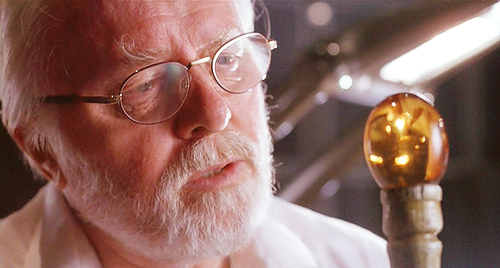
All you need is an eccentric billionaire.. Or maybe just a team of intrepid scientists! Source.
A Jurassic Park-style dinosaur resurrection, although currently being somewhat attempted by scientists in Japan (so I’ve heard) through a process of reverse-genomic engineering with chickens, (yeah), is pretty much out the window. For starters, blood sucking insects just didn’t exist back then, and there are probably a tonne of genetic issues that would make a DNA scientist genetic-hulk-smash. DNA also doesn’t last for very long – we’ve been lucky enough to extract a few small strands from frozen mammoths no more than a few tens of thousands of years old, as DNA degrades faster than a date’s interest when you start asking them what they think about the use of impact factors in academia…. (What?)

We can extract DNA from mammoths permanently mummified in permafrost! Source.
What we can find though, are the molecular traces of DNA and all the associated gooey bio-bits, but it takes a bit of technical know-how and some machine wizardry, as well as someone to lend you a dinosaur bone for a bit. A team of researchers have added the cherry on the cake to a triple whammy of awesome dino discoveries; as if finding traces of dinosaur blood vessels, osteocytes (common, star-shaped cells in mature bone), and fibrous bone matrix in dinosaurs like Tyrannosaurus rex wasn’t enough, they’ve now gone and found multiple lines of evidence that support the presence of proteins in dinosaur bone, as well as DNA! If you think about it, this is actually the first genuine proof there is that dinosaurs aren’t just mysterious rocks in the ground (although the evidence was always slightly skewed), but actually once living, breathing animals, like you or me (unless you’re a spambot, in which case, shoo!).
Osteocytes have numerous roles within bone, from sensory functions to providing maintenance. During fossilisation, it is assumed that the structures these osteocytes form are emptied after death during the degradation (rotting) processes, or infilled with some sort of mineral. However, more recent work by the same team showed that if you removed the mineral gunk from dinosaur bone, it actually releases cell-like microstructures that are consistent with the morphology of osteocytes. However, this correspondence does not mean that they are osteocytes; the fossil record and the ravages of time play host to a number of biological, chemical, and geological interactions that all conspire to deform the original structures and biogeochemistry of fossil organisms. So you need some sort of chemical fingerprint that can confirm whether or not these microstructures are actually osteocytes, and that’s exactly what Schweitzer and her team set out to do.
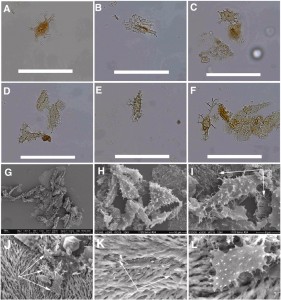
Osteocytes visualised using transmitted light (A-F) and scanning electron (G-L) microscopy. T. rex (A-C, G-I), B. canadensis (D-F, G-L). Filopodia and shape variations may be due to species, growth (ontogenetic), or physiological variations. ( From Schweitzer et al 2013) (click for larger).
Previous research by the team has demonstrated the presence of collagen, a protein that enhances tissue structure in animals, using chemical analyses of fossils of Tyrannosaurus rex and Brachylophosaurus canadensis. Using the same methods and dinosaurs, the team looked at the osteocyte-like structures and structures that are similar in form to blood vessels. The analysis had to be more targeted at proteins associated with osteocytes in avian-line animals, as often the more stable and readily preserved proteins such as actin and tubulin can show similarities to other vertebrates and even microbes.
To prepare the remains of the Cretaceous beasties, first they had to be demineralised using ethylenediaminetetraacetic acid (and breathe), with the fragments bearing the structures then sieved to concentrate parts and remove any debris. As a control experiment, the team repeated this analysis for the sediment from whence the dinosaur fossils came, as well as for their extant relatives, the ostrich and alligator, but removing all the collagen first to allow the osteocytes to be released. Using various forms of microscopy, the team could then look at the microstructures in high detail, and found that the dinosaur ones are indeed similar to those in the ostrich and alligator. They were three dimensional, and had these cool radiating spike-like filopodia that make them look a bit like deformed horse chestnut shells.
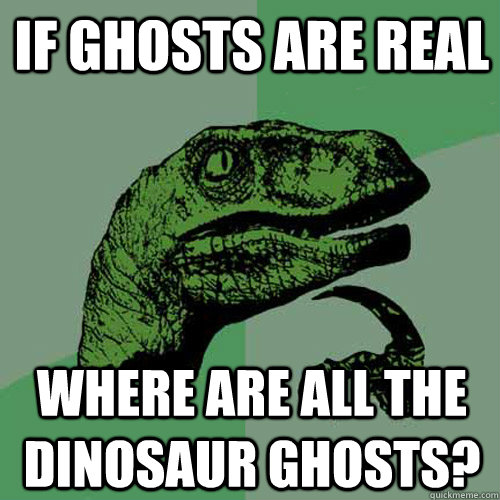
No no no, not those types of ghosts! A ‘ghost’ is a chemical or structural suggestion of something that you can no longer see.
Additionally, the team found that when they applied a test to locate DNA in the dinosaurs, the test responded positively and identified the structural ghosts of DNA within the dinosaur ‘cells’! Theirs is no direct evidence that this DNA is actually from the organism itself (endogenous), but still, pretty freakin’ sweet. The evidence for this was supported by the use of two different chemical stains, which showed that DNA structures were present in both T. rex and B. Canadensis. The staining is less intense than in modern cells (e.g., with ostriches), but importantly shows the same pattern and localisation as DNA. One of these stains is called DAPI, or 4’,6’-diamidino-2-phenylindole dihydrochloride, you know, for convenience. These stains also rule out the possibilities of the microstructures representing some sort of biofilm (bacterial origin).
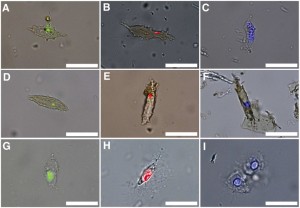
Response of dinosaur and ostrich cells to various DNA tests (top, T. rex, middle, B. canadensis, bottom, ostrich). The similar binding for all tests supports and endogenous (internal) origin of the DNA. (From Schweizer et al 2013) (click for larger).
On to the chemical analysis, the team used mass spectrometry, a method that determines the masses of the molecules within a sample, which in turn can be used to identify their composition. Both dinosaurs contained peptides (amino acids) from actin and tubulin (proteins). It also detected the DNA-associated proteins known as histones in both the dinosaur samples, adding more evidence to the structural presence of DNA, and from a source that is not related to microbes or microbial activity.
This combined structural and chemical evidence strongly suggests that what the team were looking at was in fact the remains of DNA entombed within intra-cellular osteocytes! Whether or not this DNA is explicitly of dinosaurian origin cannot be determined however without sequence data. Don’t worry though, the authors actually state that with enough ‘affinity purification’ with the use of specific antibodies may lead to sufficient and pure enough amounts of DNA to test using next-generation (cheap, fast, big data) sequencing. I think I just dino-gasmed everywhere. However, (again), due to the low positive reaction of the dinosaur cells (these are definitely dinosaur cells, it’s the DNA in them that is questionable) there may not be enough to recover sufficient amounts of usable DNA.
One final thing – did anyone here about this in the media?!
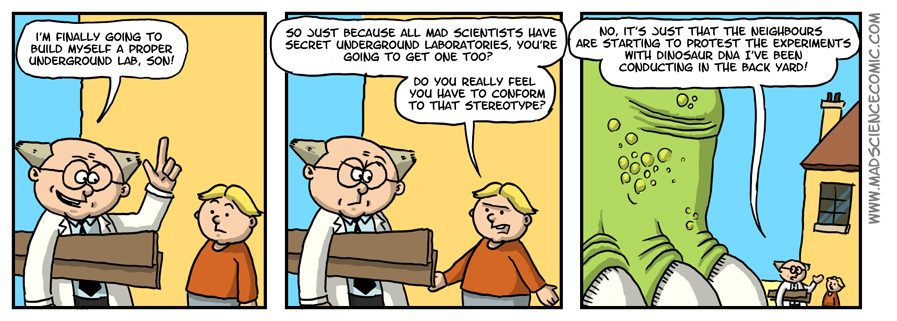
It’s not crazy, it’s science! Source.
Also, Karen James (@kejames) did this awesome up-goer five version of the abstract to explain it in the ten hundred most common words. Pretty amazing!
Reference:
Schweitzer, M. H., Zheng, W., Cleland, T. P. and Bern, M. (2013) Molecular analyses of dinosaur osteocytes support the presence of endogenous molecules, Bone, 52, 414-423 http://www.sciencedirect.com/science/article/pii/S875632821201318X (paywalled)

Schenck
Why is it that Schweitzer (and of course her collaborators) is the only paleo person that does this sort of thing? She’s been doing it for a long time too, you’d think a few other workers would have picked it up by now, must be a steep learning curve.
Socket
A lot of scientists think its a complete waste of time. It is also very expensive to carry out a lot of the analyses necessary. I know of quite a few palaeontologists who would love to look for ancient DNA but don’t have the funding or time to carry a lot of it out.
In saying that there are more people looking at ancient proteins and DNA than you would think. Within the next five years (fingers crossed) there should be a lot more studies coming out. But they will be focused on fossils MUCH MUCH older.
Karen James
To me the most convincing thing in this paper is the subcellular localization of the DNA stains (the figure you show here) and also the actin and tubulin stains (another figure from the paper). These patterns are inconsistent with the idea of post-mortem contamination with, e.g., bacteria.
E.G.
“For starters, blood sucking insects just didn’t exist back then…”
??
Mosquitoes:
http://www.mosquitocatalog.org/files/pdfs/MQ0022.pdf
Lice:
http://www.wired.com/wiredscience/2011/04/dinosaur-lice-parasites/
Philip Culver
So the conclusion is that there is NO dino DNA.
“Don’t worry though, the authors actually state that with enough ‘affinity purification’ with the use of specific antibodies may lead to sufficient and pure enough amounts of DNA to test using next-generation (cheap, fast, big data) sequencing. ”
Who is worried? Are you worried that you will not be able to connect the evolutionary dots?. You worried that God may actually be real? You worried about ending up in hell?
Jon Tennant
Chill Winston. It was ‘don’t worry – we may find dino DNA yet!’
Michael
It is difficult to take anything this article says seriously when it prints blatent illogical lies, like ‘blood sucking insects didn’t exist back then’ what are you, a lawyer?
‘DNA also doesn’t last for very long’ yeah except for the sub human species an that 700,000 yr old horse they retrieved fully intact.
The technological breakthrough an advance is proceeding in order of magnitude, it is quite overwhelming.The scientific community is very bogged down, sceptical an arrogant in it’s closed negative beliefs.
You’re looking at a hand full of poorly preserved, fragment slices from Montana no less. Dare i suggest if you painstakingly disected an entire specimen you would have enough material. An if it beyond the realms of possibility to imagine that in a decade, there would be a automated genetic sequencing algorithm, that would analyse the structures in simple puzzle like fashion. It’s not like we have templates, o wait we do, birds. Even then, unethical measures, labeling structural breaks in a living organism could help connect them. albiet with mutated remains. I find the whole scepticism e.g it could be contaminated, very bizarre, yes tiny tiny fragments of dna at some point in 65 m yr old rock sweeped into bone to trick us. I understand the epidemiological point but it’s stupid.